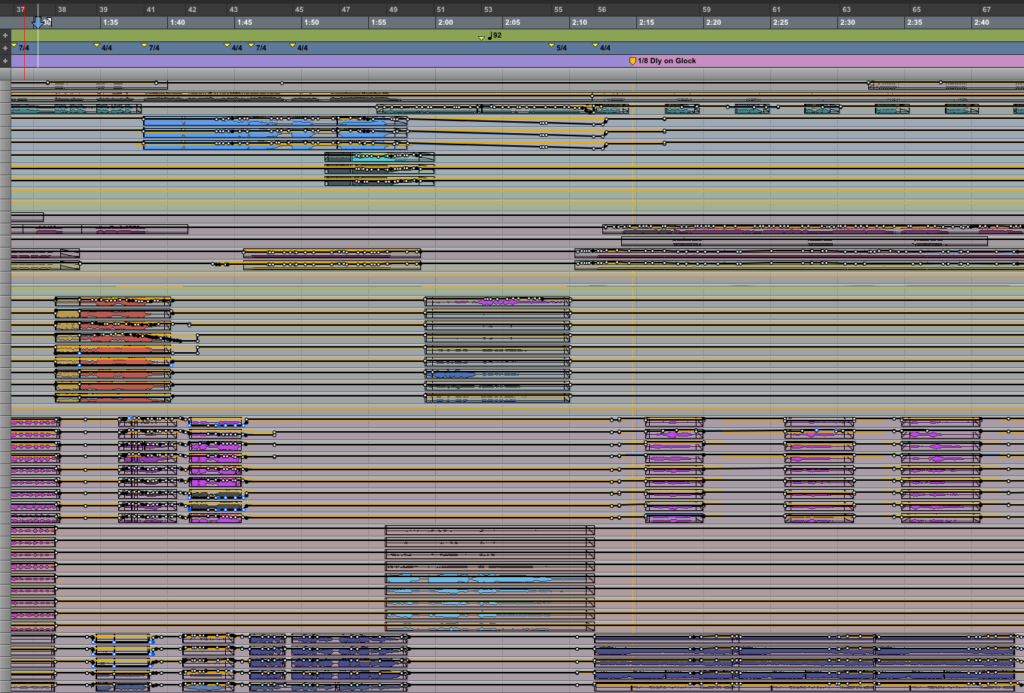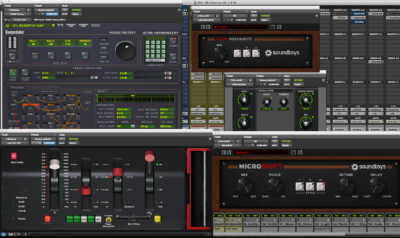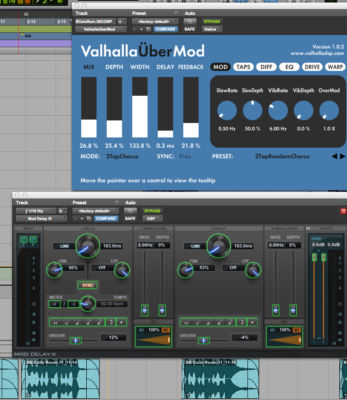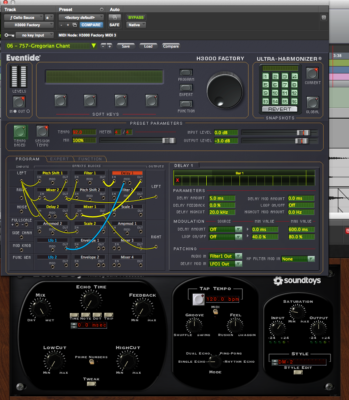Mix Analysis – Ryan Kelly, “The Colossus” by Roomful of Teeth & William Brittelle
Here was a mix project that Ryan Kelly could really get excited about.
This is one multitasking engineer, whose remarkably diverse credits range from Beyoncé, Matisyahu, Nico Muhly, Opeth, Slash, Valgeir Sigurðsson, and Tom Morello to film scores like Elliot Goldenthal’s A Midsummer Night’s Dream, and touring the world live with the epic Philip Glass opera Einstein on the Beach. No matter the capacity, Kelly has quickly emerged as a top audio pro with an ever-deepening portfolio.
There isn’t one word you should miss in this “Mix Analysis,” about a spectacular song from an equally deep documentary film project, The Colorado. From pre-mix workflow to building balances, managing a mix with MANY vocal tracks, making space, playing with extreme panning and automation, ridiculous reverbs, to a tight stereo buss mixdown chain and just plain pulling mix moves heretofore unheard of in the Modern Classical space – this one’s got it all.
Would YOU have the guts to take on this mix? Here’s what happen when an adventurous mixer is set free with an adventurous song, allowed not just to fulfill the composers and performer’s vision, but build on it. Prepare for mix inspiration…
Mixer Name and Website: Ryan Kelly – http://www.rskaudio.com
The Mix Facility: MiraVe Studios, Jersey City NJ
Artist and Song: Roomful of Teeth & William Brittelle – The Colossus
Stream It Here:
Massive Mission: The Colorado is one of the most ambitious projects I’ve been involved in. It’s a documentary film that is also intended as an educational and live performance piece.
The film was directed by Murat Eyuboglu, and written by five composers; John Luther Adams, William Brittelle, Glenn Kotche, Shara Nova & Paola Prestini. The vocals were performed by the fantastic Roomful of Teeth with Jeffrey Zeigler on cello and Glenn Kotche on percussion. I definitely recommend taking a look at the website to learn more about everything that went into the making of this film and its message.
A Mix Match: I’ve previously worked with William programming live setups for his performance rigs. He told me about the Colorado project which was still in the writing stage at that point and I had to be involved!
Over the next few months I talked with Paola Prestini and the team at VIA about the recording plan and how we would approach it. They had a really great team put together already and we shared a vision for how the pieces would turn out. Over the past years I’ve mixed FOH and monitors for quite a few Modern Classical artists and became familiar with Roomful’s music and some of the performers. I was incredibly excited to be joining them on this project, and it was a blast to work on.
Studio of Choice: I mixed the album at my studio, MiraVe, in Jersey City. Frank Comentale designed and built the room for me a few years ago and now I do about 95% of my mixes there.
I run a Pro Tools HDX system with an Avid Omni and HD 16/16 for conversion. The Omni feeds a set of Eve SC307 monitors and Sennheiser HD 800’s. For these mixes I used two Avid Artist Mixes and an Artist Control mixing entirely in the box except for my RND MBP-II and GML EQ.
Construction materials: I tracked the vocalists at the lovely Studio Dolce Vita in NYC, they were arrayed in a semi-circle around the conductor with a Schoeps MK41 on each singer and a pair of Milab VIP-50’s for the ensemble blend.
For the music, Pat Burns did a wonderful job of recording the percussion and cello out at MinBal Studios in Chicago. After the vocal tracking was completed, I spent a couple of weeks editing and sorting out a workflow for the mix that at times included a small assembly line of second engineers (Thanks Jay Wujun Yow and Barbara Schucko!) working on the edits after comps were chosen and prepped each song for mixing.
Initial Pass: Bill’s songs were definitely the most interesting to mix with regard to effects. “The Colossus” had so much space for effects and processing that I was really excited to dive in. I worked on the track in layers since there were so many tracks and elements. I use a pretty standard set of Track Colors across mixes to help visualize where everything is coming in and what sort of thing it is. All of the tracks were mixed into Aux Stems which are then summed to my print track for easier global adjustments.
My previous discussions with William about the song and the guide tracks helped develop my initial outline of where I wanted to go with it. Even with that initial idea, the track definitely evolved throughout the mix and William’s first feedback was to push it even further! Some of the stuff we did I would have never imagined implementing in a more classical piece but they ended up blending and propelling the song in some great ways.
Mixing It! I began building balances of the instruments while we were tracking the vocals so I started with those and went through all the other pre-records.
In a couple of cases (the bass drum, for example) I used the guide track and blended it in with the acoustic ones. Filtering out all the top end of the samples helped add a bit more Sub to those hits. I started out with Avid’s Channel Strip on every track for basic sculpting, clearing out space wherever I could. Once the music bed was EQ-d and holding together with some basic rides, I brought in the main vocal lines.
One of the other big differences with these mixes versus most vocal music is that William loves panning almost as much as I do! Pretty much every pan automation move you can imagine was tried at various times and we didn’t let reality get in the way (“Of course the singer could silently run to the other side of the room while sustaining the note, she’s a professional!”). There are far too many instances of this to list but I love the movement it added to the track and some of the transitions wouldn’t be the same without it.
While recording this piece we split the men and women on some sections where they were rhythmically very different to help with isolation, and then we tracked them all together for the more ensemble parts. For the vocals I mostly just used HPF’s (Image 7) set for each singer’s range and a couple of cuts where needed. All of the vocals were then sub-mixed through a UAD 33609 compressor, and that was it!
They all had individual sends to a pair of reverbs (a UAD 250 set to a medium decay and a Lexicon RHall set a bit shorter with a longer pre-delay). Depending on which line was in the foreground at a particular place I adjusted which reverbs they were hitting to move the backing lines, well, back, to help with clarity of focus.
In a couple of sections I used the Choir guide tracks from Bill’s mockup to create moving textures underneath the live vocals. A good example of this is at 2:10 under the men’s voices, I have a UAD Moog Filter with the cutoff automated in time feeding a short reverb. Another version of that idea happens at 5:03. Here, I printed a submix of the men’s vocal chord from the previous bars and then pitch shifted it down and time stretched it before running that through a Moog transitioning into the cello outro.
One of my favorite vocal effects is at the very end (5:09). Bill wrote in a warble for all of the singers that we tracked multiple variations of. They got a really cool sound acoustically in the room and, of course, I couldn’t leave well enough alone! I fed those vocals through two independent paths (FX Image A above) which are layered underneath, and it still make me happy every time I hear it.
Back at 2:10 I used Valhalla ÜberMod multitap delay and modulation plugin on the cello feeding a 1/16th ModDelay to get the bouncing line William was hearing in his head. Jumping ahead to 3:15, that same delay comes back in but instead of ÜberMod, I’ve a got a parallel feed of the cello running through EchoBoy’s DM2 setting with the time set to zero that is feeding the same delay and then both are feeding an H3000 patch throughout this section (See FX Image C, below).
The biggest change that happened during the mix is at 4:20. Initially that was a space letting the vocals hang, but in my head I kept hearing drums coming in there. William gave me some time to work on an idea I head and even more graciously agreed to leave it in. I took another section of the choir guide tracks, ran them through bx_Saturator and a high shelf from MH Channel Strip into Little Radiator and Echoboy on the Telephone setting. On top of that, I spliced some of Glenn’s tom hits for the rhythm.
These additional sounds really made the transition a lot more impactful in my mind and was a lot of fun to create!
Mixdown: My mixdown setup was pretty simple. The stereo bus hit a Slate VCC plugin set to FG-N, a UAD NSEQ-2 rolling out a little 250Hz and then my RND MBP-II Compressor. The compressor barely hit 2dB of reduction on the loudest sections but I use the variable silk and a touch of Width EQ on most everything I mix! I recorded and printed everything at 96k which allowed Oscar to include high resolution versions along with the CD quality prints in mastering.
Yes Master: Oscar Zambrano mastered this at his wonderful studio, Zampol Productions. Listening through to the album on his wonderful setup was a huge reward after all the work that went into this one.
It All Adds Up: One of the most important things I can say about working on something like this with so many pieces is to just jump in and start piecing it together one track at a time.
The Colorado is one of my favorite albums that I’ve ever worked on! It was a wonderful opportunity to bring some of my experience from Pop/R&B records to modern classical pieces that were beautifully written and performed.
The care all of the composers took with their writing and arrangements really comes through. It’s an album I’m incredibly proud of.
— Ryan Kelly, http://www.rskaudio.com
Please note: When you buy products through links on this page, we may earn an affiliate commission.












